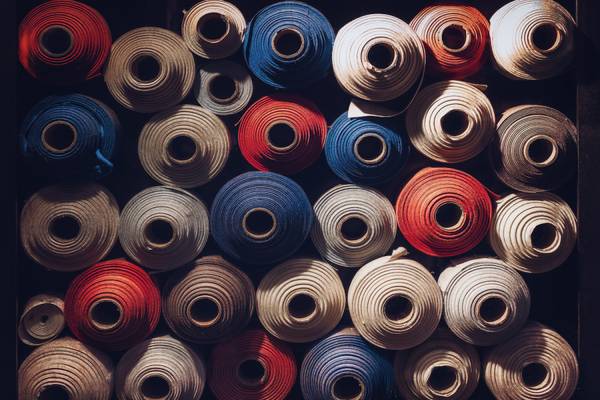
How To Tell If Fabric Is… (How to Identify Fabrics Easily)
Humans have identity cards. If you do not have one, you may not be able to participate in a variety of opportunities every country offers its citizens. Unfortunately, fabrics do not carry identity cards thus it either takes the confession of the manufacturer or simple tests to see which fabric is which.
The easiest way to tell which fabric is which is to do the burn test. It is fast, simple and if you know what to look for you should find the identity of your fabric quickly. However, all fabrics do not burn differently, so you may need extra help in identifying which material you are buying.
To find that extra help, just continue to read our article. It is filled with the facts you need to make sure you know which fabric is in your shopping cart. It will take more than a few minutes to go through but your time will be well spent as it has different ways to tell one fabric from another.
How Can I Identify Fabric?
There are several ways you can go about doing this. Once you have learned those ways, a touch or a look will help you see the difference between the materials. The go-to test is as mentioned earlier, the burn test.
Since fabrics burn differently, for the most part, you can tell which is which by the odor they give off, the look of the flame, or the ash residue they leave behind. Then you can tell some fabrics just by their feel or their look. While there are synthetic fibers created to mimic natural ones, there should be a difference in their feel and look.
If not, then you do the burn test as natural fibers and synthetic ones burn differently. Silk does not feel like wool and polyester certainly does not feel like cotton or silk or hemp or any other natural fiber.
Identify Fabrics Through Visual Inspection
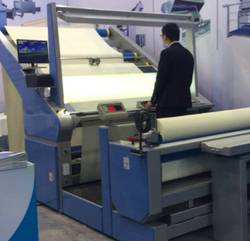
The good thing about the majority of fabrics is that they all don't look the same. Mesh and netting may be close but you should be able to tell them apart by the size and shape of the holes in the fabric. Then it is not that hard to see a sheer fabric and tell it apart from a heavyweight or medium weight material.
Silk, chiffon, rayon, and other lightweight fabrics usually are not heavyweights like canvas, denim, and duck cloth. Then you can tell some fabrics just by seeing their color. Denim, for the most part, is dyed with an indigo blue color or it can be black.
But, this option relies on the assumption you already know enough about the different fabrics to tell them apart just by looking at them. This is an earned skill as it may be hard to tell sheen, from matte and so on by beginners.
How to Identify Fabric by Hand
Touch is always a good way to tell a fabric. Most synthetic products tend to have an artificial feel about them. Try as they might the different manufacturers have not completely eliminated that texture from synthetic materials.
Then generally, wool can feel soft and rough or it can feel soft and smooth depending on the type of wool and how it was woven. If you are not sure something is cotton or not, you can always tell by feeling the fabric’s weight. Cotton comes in a variety of weights while other natural fabrics do not.
Then certain fabrics are ribbed, coarse, and bulky. Those are key aspects to help you identify the material it is made from. This link will give you more tips on what to look for when touching and looking at the fabric.
How to Identify a Vintage Fabric
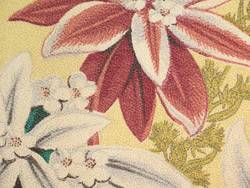
First off, you should look at the color of the tapestry. If there is a grayish hue or tint, with the pastel coloring, then the material should be from the Victorian age. Also, you should see a continuous weft or horizontal thread on the backside of the material.
If the antique fabric has discontinuous cross-woven threads then it was handwoven. Second, look at the color. Since the ancient civilizations didn't have access to modern chemical dyes, their plant-based dyes will be more faded. If the back side is not faded but the front is, then it was a handwoven fabric.
Finally, you may be able to see a ‘story’ built into the fabric. Ancient materials may have a religious or mythology motif while Victorian fabrics may have scenes from exotic locations.
How to Tell if a Fabric is Silk
You do not have to do a burn test to see if the silk is real or not. Most fabric stores frown on such tests and may ban you from coming back if they see a lighter in your hand. All you have to do is rub it. If the material is real silk, you should get a warm feel from it.
Next, pull your wedding ring off and try to pull the lightweight silk material through it. Artificial silk can’t pass this test. It will bunch up while real silk will be flexible and be pulled through easily. Third, you can always look at the price tag. Real silk is not cheap and about 10 times more expensive than fake silk.
Identify Satin Fabric
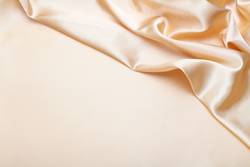
With satin trying to look like and feel like silk, there are ways to tell them apart. First, satin has a glossy look to its material while silk has a shimmering look that makes it stand out. Second, satin will have a glossy and dull side to it while silk will look the same on both sides.
Third, pull on the two fabrics. Satin will have a little flexibility to it while silk remains firm and hardly moves at all. Silk is not a stretchable material. Finally, run your hand gently across the fabric like you are caressing a loved one’s face. Satin is a little rougher than silk is.
How to Tell if a Fabric is Linen
If you do the burn test, then the material you burnt will burn slowly and give off a rope-like odor. But if you are in a location that does not like its fabrics burnt, then wet your finger with some water and place a drop or two on the material. If the water goes right through the material immediately, then it is linen.
If you do not have any water handy, then use your thumb and finger and pinch a little piece of the material. You should see a few wrinkles and the material should bounce right back if it is 100% linen. Then a drop of oil will make linen transparent while a drop of ink will spread evenly if the material is 100% linen.
Identify Flannel Fabric
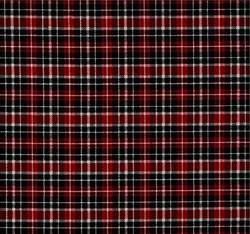
One good thing about flannel is that it can be made from a variety of natural and synthetic fibers. But not all of those fibers will qualify. Silk is one that is excluded from making flannel. It is just not soft enough. That is one way to tell if you have flannel or not. It is very soft.
That softness will also help you exclude many other fabrics as well. If you are still not sure, then go to the burn test to help narrow the material options down. You will find that flannel will burn according to the fibers it is made from.
If it is polyester, the flannel should melt and if it is made from cotton, then you should see flames and smell burning paper.
Identify Jacquard Fabric
First off, look at the pattern and the color. If you see that it is printed or dyed onto the fabric, then it is not jacquard material. The color and pattern are put into the weave first before it is made into a fabric. Second, the term jacquard refers to the weave style not the type of fabric. This material is made from cotton, polyester, and other fibers so it is not a unique material.
It also comes with different textures so identifying it right off is not always going to be easy. A special loom is used to create this material but the burn test may be the best way to tell if the fibers used are natural or synthetic.
Identify Jersey Fabric
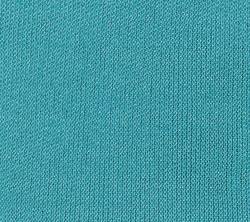
First off, you should try to bunch the fabric up. If it is a jersey knit then it should not wrinkle and it should bounce back quickly. Second, you can pull on it as jersey knit stretches more than woven fabrics. If that is not enough to convince you then look at the pattern. There is a right and wrong side to this material and one side will be duller than the other.
Another way to tell if it is a jersey knit or not is to look at the stitch pattern. A jersey knit has knit stitches on the front and purl stitches on the back. Those are the 3 easiest ways to tell other than using the burn test.
How to Tell if a Fabric is Chiffon
This is another fabric that is made from different fibers. If the chiffon material is made from polyester, it should not have much stretch to it. If it is made from silk, there will be a little stretch because of the way the fibers were woven.
Then if you are not convinced, look at the appearance of the fabric. Silk chiffon will shimmer as real silk does. Cotton chiffon will have a more matte look to it. All types of chiffon will be a bit rough due to the puckers created by the s and z twists.
On top of that chiffon usually has a tighter weave than similar fabrics. There are other sheer materials out there but they should not feel like chiffon does.
Identify Lycra Fabric
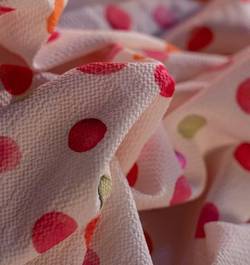
The key to knowing which is or isn’t lycra is to understand that this is not a fabric name. It is a brand name and lycra, elastane and spandex are all the same material. There is no difference between these fabrics and they should all expand to 3 to 5 times their size approx.
The stretch in Lycra will tell you if it is elastin and not silk or cotton, or hemp. Those fabrics do not have a lot of stretch to them and are often blended together to get them to stretch out. Plus, the material should have an artificial feel to it as it is not made from natural fibers at all.
You may find it feels like plastic as it is made from the same chemical compounds that many plastics are made from today.
Identify Lace Fabric
In the old days, you could find lace made from either gold or silver. Those materials are easy to identify and need no help from us. Then silk was also used and the lace would have a shimmer to it that only silk can provide. The linen lace was a little more matte in style and color.
In today’s world, you may not find lace in gold or silver but you may find it in cotton and that material is easy to tell apart from silk. There won’t be that shimmer and cotton should be better looking than linen as well as cheaper.
But to identify lace you may have to look at the style it is made in. There are a lot of different ways to create lace using those fabrics. Just click this link to see those styles. A knit lace will be softer and more flexible than other styles of this material.
Identify Muslin Fabric
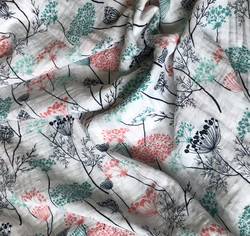
Muslin is usually made from cotton. If it is made from other fibers, the burn test will tell whether or not those fibers are cotton, synthetic, or some other natural fiber. If you are still not sure you have found the right muslin material, then look at the weave style.
Muslin is made with a plain weave with crisscrossing threads. Because it comes in different weights and thread counts, it may be hard to tell if you are holding regular cotton or muslin cotton but one thing is for sure, the muslin is cotton and will burn like that material.
Fabrics are harder to tell apart when they come from the same source and you have to go to the weave style to identify them.
How to Identify Nylon Fabric
If you are having a hard time telling which fabric is polyester and which is nylon, do a water test. The nylon fabric will absorb more water than the polyester material. Then if you are not sure if you are holding nylon try the dye test. Nylon is not good at holding onto its color.
Also, nylon is a lot more flexible than most fabrics, outside of Lycra, so give it a gentle tug and see how far it stretches out. It should stretch further than most natural fibers and a majority of synthetic ones. The feel of nylon will not be natural so it is easy to tell that fabric from wool, cotton, hemp, and so on.
Nylon should feel more plastic-like or artificial.
Organza Fabric
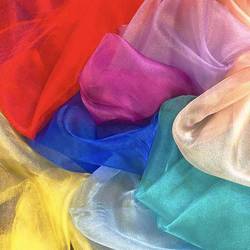
This material is also sheer like chiffon and similar fabrics but one difference that helps you tell it apart is that it is made from a plain weave like muslin fabric. Normally, and if you can afford it, the material is made from silk. That material has its well-known qualities attached to this fabric.
But since the advent of synthetic materials, polyester and nylon are also used. To tell them apart you can do the water or the burn test. If it doesn’t burn but melts, then it is made from nylon or polyester. If it does burn and smells like burning hair then it is made from silk. Just be careful as this is a very delicate fabric to handle
Identify Polyester Fabric
When polyester first came out, no one had to be an expert at identifying different fabrics. Polyester had a very artificial feel and look which could be spotted from a mile away. But things change and the manufacturing process for polyester has changed making it a little more difficult to identify.
As usual, if you can, do the burn test to see which material you have. Or you can hold it up to the light and see if it has a constant white texture to the material. Silk’s texture will change colors but not polyester’s.
Then polyester has a robotic-like weave style to it with every thread in perfect order, symmetrical and even. Natural fibers don't come with that quality. On top of that, polyester prints normally don't show up on the wrong side of the material. Silk’s will as will many other fabrics.
Finally, polyester’s price will clue you in as to which fibers were used to make this fabric.
Identify Viscose Fabric
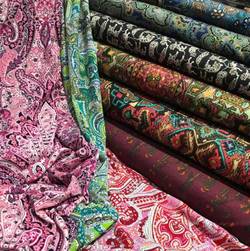
When you do the burn test, you may find that viscose results are very close to rayon’s. That is because the viscose material is a form of rayon and it is manufactured in the same way using wood chips and chemicals.
One of the problems of identifying viscose, outside of reading the label, is that it is not always made from the same wood chips. It can also be manufactured from beech tree and bamboo. The water test should help you as the material is very absorbent, unlike other fabrics.
Both the water and burn tests just narrow down the field of fabric options as other fabrics may have the same qualities or produce the same residue, etc. If you wash the material after conducting the burn test, then the shrinkage rate and wrinkles should help you identify it quickly.
Velvet Fabric
The silk version of this fabric is a lot softer than the other materials used to create velvet. It will be that softness that stands out the most. Then velvet is usually made with two warp threads and one weft thread. Viscose velvet has a very lustrous look to it that has the material shimmering almost as good as silk does.
The linen version of velvet comes with a more matte look and no real sheen to it. Finally, the cotton version of velvet has a shorter pile than the silk version. It is also not as sheen looking or as soft. What makes telling these different versions of velvet apart is that the maker of the material may use more than one fiber in its construction.
How to Identify Wool Fabric
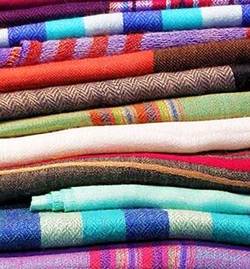
One reason you need to tell the different fabrics apart is that you might be allergic to one of the fibers or the different chemicals that are used to create that fabric. Knowing the difference spares you a lot of pain and hassle. Also, it saves you money.
For wool, there are people allergic to this material or some of the different versions, so telling them apart is vital for them. There is the burn test and you know about that already. There is also a bleach test. Only use a small amount of wool and soak it in bleach for about 8 hours.
If the material is almost or completely gone, then it is real wool. There is the felt test as well and if the fabrics pull apart after being made wet and shoved together then it is not wool.
Some Final Words
Identifying the different fabrics is important. As we just said, you need to protect yourself from any allergic reaction or from spending too much money. There is another important reason and that is you do not want to use the wrong fabric in your sewing project.
The look and feel will be different from what you expected.

